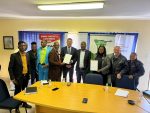Twelve scientists from Southern African Development Community (SADC) countries will head to Germany in May, where they will have an opportunity to obtain more in-depth insight into green hydrogen amid the region’s unveiling of important green hydrogen projects, pilot plant initiatives and the awarding of a large number of green hydrogen scholarships.
Prominent last week during the Sasscal-organised two-day Green Hydrogen Symposium in Namibia was Sasscal executive director Dr Jane Olwoch, who emphasised “the countries of Southern Africa should first and foremost take note of the region’s advantages of participating in the green hydrogen economy”.
“History is in the making and I’m very glad we’re part of it,” added Olwoch.
Sasscal is SADC’s science service centre for climate change and adaptive land management.
The symposium for the participating countries, such as Angola, Botswana, Democratic Republic of Congo, Eswatini, Malawi, Mauritius, Mozambique, Namibia, South Africa, Tanzania, Zambia and Zimbabwe, accentuated green hydrogen practice, fast-advancing pilot plants and far-reaching skills development to support Southern Africa’s green hydrogen thrust.
In addition to the dozen selected scientists, Olwoch announced that the first cohort of students would be leaving for Germany immediately after the symposium, with others following later.
Moreover, the symposium itself brought together representatives from industry, universities, governments and adolescents to witness the green hydrogen journey that Sasscal has been coordinating.
“The price of green hydrogen is on its way to becoming affordable,” said Olwoch, reaffirming its status as being more sustainable than any other energy on offer.
On the sidelines of the Green Hydrogen Symposium, Dr Olwoch had an interview with Engineering News & Mining Weekly reproduced below:
What is the present state of green hydrogen development in the SADC region?
Olwoch: Here in Namibia, there are projects on the ground that are going to produce green hydrogen in the next few years. One of these that is advancing really well is the Daures Green Hydrogen Village pilot project, which is 100% funded by the German Federal Ministry of Education and Research. All the preparatory steps have been taken. Its development is progressing in the desert of Namibia, where borehole water and equipment are opening the way for the generation of green hydrogen. Electrolysers have been imported and green ammonia will also be produced from what could be our first green hydrogen project. In addition, we’ll have a refuelling station and the hope is that the green hydrogen from this will be transported to enable others to use it for many applications. We have also taken capacity building into consideration and young Namibians are taking charge of these projects as part of a really amazing story of cooperation between Germany and Namibia.
What is the level of skills development being generated by your Youth for Green Hydrogen scholarship initiative?
Once again, this is fully funded by Germany’s Federal Ministry of Education and Research and it sponsors the entry of young Namibians, between the ages of 18 and 35, into the field of green hydrogen development. There are already about 160 young Namibians in this programme. Last year, scholarships were awarded to 70 young students, 49 of them with master’s degrees, and the rest with vocational qualifications. This year, for another 90, we’ll reverse the order. Instead of a majority of master’s graduates, most will be from the value chain, be it production, transportation, safety, welding, solar, mechanics and desalination. An advantage is that they’ll also spend six months at a German institution. These students are from and for the SADC as a whole and they’ll be available for employment in the next two years to ensure green hydrogen sustainability in our region. It’s a very good programme and we’re very grateful to Germany’s Federal Ministry of Education and Research.
What is it about renewable energy and green hydrogen that so important for the African continent?
We always tell ourselves that Africa is not a big emitter and yet when climate change strikes, the continent suffers floods and droughts in particular. So, yes, Africa is heavily affected by climate change and we must take responsibility, adapt and contribute to the reduction of greenhouse gases. But combatting of climate change also presents opportunity, as green hydrogen is doing by presenting new industrial and commercial prospects for the transition to cleaner energy. Green hydrogen provides the opportunity for countries to clean up the environment, restore ecosystems and to provide jobs, technology and new skills for the future.
When will green hydrogen become economically competitive?
It’s almost there. Starting phases invariably take a bit longer because of the need to educate, research and prepare our countries to be able to implement the green economy. It is also important to know that our countries are positioning themselves to take advantage of the renewable energy resources at their disposal. We’ve done the research, we’re building the capacity and now the policies and regulatory frameworks must kick in. I’m very happy to say that our countries are strategically on track. We’re close to implementation, which we must ensure is done well. We want to produce the green hydrogen that will be most economically attractive to ourselves and to the world.
Why is it so regionally critical for Southern Africa that the world adopts platinum-based PEM electrolysers and platinum-based PEM fuel cells that are green hydrogen-driven?
This is critical because it is so crucial for the region to bring in the other resources that we have. Platinum is extremely important. We are not only going to be producing green hydrogen, but we are also going to be using natural resources to produce products domestically for export to other countries, and there are many options open to us.
What should be the biggest takeaway from all this?
The biggest takeaway should be that our countries must give research a chance before they invest a lot of resources into commercial production of green hydrogen. There is a lot we don’t know about green hydrogen safety and transportation. Also, South Africa and Namibia need to know more about desalination of sea water. So, I’m saying do more research and skill our people so that we can sustain the green hydrogen economy.










